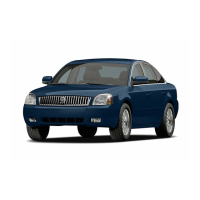

Do you have a question about the Mercury 2006 Montego and is the answer not in the manual?
| Brand | Mercury |
|---|---|
| Model | 2006 Montego |
| Category | Automobile |
| Language | English |
Alerts you to vehicle conditions that may require attention and explains their meaning.
Provides information on vehicle speed, engine coolant temperature, fuel level, and engine speed.
Features and controls for the optional DVD system.
Operation of the automatic climate control system for driver and passenger.
How to set, increase, decrease, and disengage speed control.
Programming and operation of the HomeLink system.
How the anti-theft system works and its indicator.
How the system determines airbag deployment based on occupant.
Safety precautions for children in relation to airbags.
Guidance on when and how to use booster seats.
Proper procedures and recommendations for inflating tires.
Understanding payload, Gross Vehicle Weight, and Gross Axle Weight.
Ignition positions and procedures for starting the vehicle.
Information on brake noise, warning lights, and ABS.
Details on the complimentary roadside assistance program coverage.
Instructions for changing a flat tire.
Safety precautions and procedures for jump starting a vehicle.
Procedure for reporting vehicle safety defects to NHTSA.
Procedures for checking and adding engine oil.
Checking and adding engine coolant and its specifications.
Methods for calculating and improving fuel economy.
Understanding the OBD-II system and malfunction indicators.
Checking and maintaining brake fluid levels.
Checking and maintaining automatic transaxle fluid.